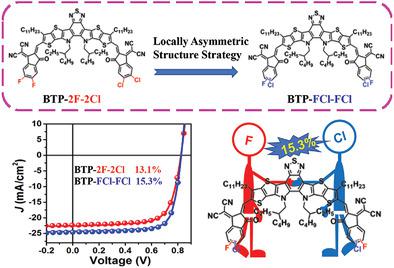Our official English website, www.x-mol.net, welcomes your
feedback! (Note: you will need to create a separate account there.)
15.3% Efficiency All‐Small‐Molecule Organic Solar Cells Achieved by a Locally Asymmetric F, Cl Disubstitution Strategy
Advanced Science ( IF 14.3 ) Pub Date : 2021-02-22 , DOI: 10.1002/advs.202004262 Dingqin Hu 1, 2 , Qianguang Yang 1, 3 , Yujie Zheng 2 , Hua Tang 1, 3 , Sein Chung 4 , Ranbir Singh 5 , Jie Lv 1 , Jiehao Fu 1 , Zhipeng Kan 1, 3 , Bo Qin 2 , Qianqian Chen 1, 2 , Zhihui Liao 1, 3 , Haiyan Chen 1, 2 , Zeyun Xiao 1, 3 , Kuan Sun 2 , Shirong Lu 1, 3
Advanced Science ( IF 14.3 ) Pub Date : 2021-02-22 , DOI: 10.1002/advs.202004262 Dingqin Hu 1, 2 , Qianguang Yang 1, 3 , Yujie Zheng 2 , Hua Tang 1, 3 , Sein Chung 4 , Ranbir Singh 5 , Jie Lv 1 , Jiehao Fu 1 , Zhipeng Kan 1, 3 , Bo Qin 2 , Qianqian Chen 1, 2 , Zhihui Liao 1, 3 , Haiyan Chen 1, 2 , Zeyun Xiao 1, 3 , Kuan Sun 2 , Shirong Lu 1, 3
Affiliation

|
Single junction binary all‐small‐molecule (ASM) organic solar cells (OSCs) with power conversion efficiency (PCE) beyond 14% are achieved by using non‐fullerene acceptor Y6 as the electron acceptor, but still lag behind that of polymer OSCs. Herein, an asymmetric Y6‐like acceptor, BTP‐FCl‐FCl, is designed and synthesized to match the recently reported high performance small molecule donor BTR‐Cl, and a record efficiency of 15.3% for single‐junction binary ASM OSCs is achieved. BTP‐FCl‐FCl features a F,Cl disubstitution on the same end group affording locally asymmetric structures, and so has a lower total dipole moment, larger average electronic static potential, and lower distribution disorder than those of the globally asymmetric isomer BTP‐2F‐2Cl, resulting in improved charge generation and extraction. In addition, BTP‐FCl‐FCl based active layer presents more favorable domain size and finer phase separation contributing to the faster charge extraction, longer charge carrier lifetime, and much lower recombination rate. Therefore, compared with BTP‐2F‐2Cl, BTP‐FCl‐FCl based devices provide better performance with FF enhanced from 71.41% to 75.36% and Jsc increased from 22.35 to 24.58 mA cm−2, leading to a higher PCE of 15.3%. The locally asymmetric F, Cl disubstitution on the same end group is a new strategy to achieve high performance ASM OSCs.
中文翻译:

通过局部不对称 F、Cl 取代策略实现 15.3% 效率的全小分子有机太阳能电池
使用非富勒烯受体Y6作为电子受体实现了功率转换效率(PCE)超过14%的单结二元全小分子(ASM)有机太阳能电池(OSC),但仍落后于聚合物OSC。在此,设计并合成了一种不对称Y6类受体BTP-FCl-FCl,以匹配最近报道的高性能小分子供体BTR-Cl,并实现了单结二元ASM OSC的15.3%的记录效率。BTP-FCl-FCl在同一端基上具有F,Cl二取代,提供局部不对称结构,因此与整体不对称异构体BTP-2F相比,具有更低的总偶极矩、更大的平均电子静电势和更低的分布无序性‐2Cl,从而改善电荷的产生和提取。此外,基于 BTP-FCl-FCl 的活性层具有更有利的畴尺寸和更精细的相分离,有助于更快的电荷提取、更长的载流子寿命和更低的复合率。因此,与BTP-2F-2Cl相比,基于BTP-FCl-FCl的器件提供了更好的性能,FF从71.41%增强到75.36%,J sc从22.35 mA cm -2 增加到24.58 mA cm -2,PCE高达15.3% 。同一端基上的局部不对称F、Cl二取代是实现高性能ASM OSC的新策略。
更新日期:2021-04-22
中文翻译:

通过局部不对称 F、Cl 取代策略实现 15.3% 效率的全小分子有机太阳能电池
使用非富勒烯受体Y6作为电子受体实现了功率转换效率(PCE)超过14%的单结二元全小分子(ASM)有机太阳能电池(OSC),但仍落后于聚合物OSC。在此,设计并合成了一种不对称Y6类受体BTP-FCl-FCl,以匹配最近报道的高性能小分子供体BTR-Cl,并实现了单结二元ASM OSC的15.3%的记录效率。BTP-FCl-FCl在同一端基上具有F,Cl二取代,提供局部不对称结构,因此与整体不对称异构体BTP-2F相比,具有更低的总偶极矩、更大的平均电子静电势和更低的分布无序性‐2Cl,从而改善电荷的产生和提取。此外,基于 BTP-FCl-FCl 的活性层具有更有利的畴尺寸和更精细的相分离,有助于更快的电荷提取、更长的载流子寿命和更低的复合率。因此,与BTP-2F-2Cl相比,基于BTP-FCl-FCl的器件提供了更好的性能,FF从71.41%增强到75.36%,J sc从22.35 mA cm -2 增加到24.58 mA cm -2,PCE高达15.3% 。同一端基上的局部不对称F、Cl二取代是实现高性能ASM OSC的新策略。











































 京公网安备 11010802027423号
京公网安备 11010802027423号